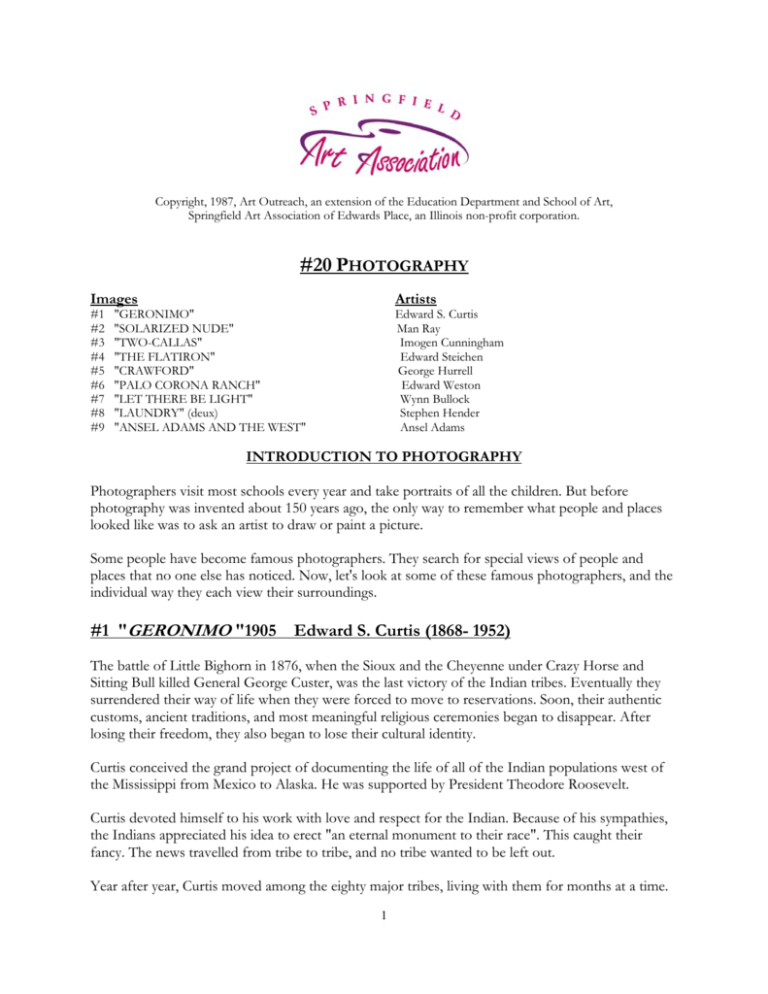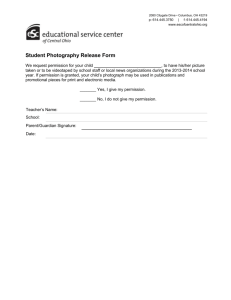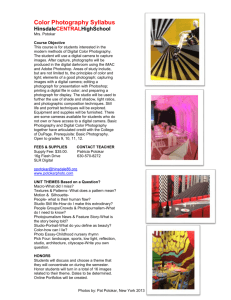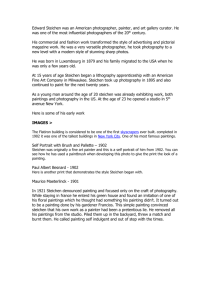#1 "GERONIMO "1905 Edward S. Curtis (1868
advertisement

Copyright, 1987, Art Outreach, an extension of the Education Department and School of Art, Springfield Art Association of Edwards Place, an Illinois non-profit corporation. #20 PHOTOGRAPHY Images #1 #2 #3 #4 #5 #6 #7 #8 #9 Artists "GERONIMO" "SOLARIZED NUDE" "TWO-CALLAS" "THE FLATIRON" "CRAWFORD" "PALO CORONA RANCH" "LET THERE BE LIGHT" "LAUNDRY" (deux) "ANSEL ADAMS AND THE WEST" Edward S. Curtis Man Ray Imogen Cunningham Edward Steichen George Hurrell Edward Weston Wynn Bullock Stephen Hender Ansel Adams INTRODUCTION TO PHOTOGRAPHY Photographers visit most schools every year and take portraits of all the children. But before photography was invented about 150 years ago, the only way to remember what people and places looked like was to ask an artist to draw or paint a picture. Some people have become famous photographers. They search for special views of people and places that no one else has noticed. Now, let's look at some of these famous photographers, and the individual way they each view their surroundings. #1 "GERONIMO "1905 Edward S. Curtis (1868- 1952) The battle of Little Bighorn in 1876, when the Sioux and the Cheyenne under Crazy Horse and Sitting Bull killed General George Custer, was the last victory of the Indian tribes. Eventually they surrendered their way of life when they were forced to move to reservations. Soon, their authentic customs, ancient traditions, and most meaningful religious ceremonies began to disappear. After losing their freedom, they also began to lose their cultural identity. Curtis conceived the grand project of documenting the life of all of the Indian populations west of the Mississippi from Mexico to Alaska. He was supported by President Theodore Roosevelt. Curtis devoted himself to his work with love and respect for the Indian. Because of his sympathies, the Indians appreciated his idea to erect "an eternal monument to their race". This caught their fancy. The news travelled from tribe to tribe, and no tribe wanted to be left out. Year after year, Curtis moved among the eighty major tribes, living with them for months at a time. 1 He recorded their habits, customs and songs. He photographed their most representative faces, their activities, tools, and ceremonies, all against the landscapes they had inhabited for centuries. • • • Who do you think this is? o Geronimo, Chief of the Apache Nation. As a result of the efforts of early photographers, much of our country's history is pictorially documented. Why do you think it is in black & white instead of color? o Because color photography wasn't invented till many years later. What do you feel about Geronimo when you look at this photograph? #2 "SOLARIZED NUDE" by Man Ray (1890 - 1976) Man Ray was an American, but lived most of his life in France. He was also an accomplished artist before he turned to photography. He experimented with a wider range of styles and technical methods than practically any photographer in history. • • • Does this look like a painting or a photograph? Could you imagine this photograph if it were in vivid colors? Would you like it better? What shapes do you see? #3 "TWO-CALLAS" Imogen Cunningham 1929 (1883 - 1976) Imogen Cunningham was a free spirit and a wonderfully sensitive early photographer. But it wasn't until she was in her 80's that she became famous. • • • What do you think this is? o It is a close-up view of the inside of two flowers. Why do you think Cunningham took the picture so close up? o For emphasis. Do you see all the shapes and lines? Sometimes a close-up detail is more powerful than seeing the whole. The next time you are outside and see a flower, bend down and look at the flower, really look at it, the way Imogen Cunningham did. #4"THE FLATIRON" 1905 Edward Steichen (1879 - 1973) In 1917 Steichen commanded the Photographic Division of the Air Service. After the war he spent a year establishing aviation photography in the Armed Forces on a permanent basis. But Steichen will most be remembered for his struggle to get photography recognized as an art form. In his attempts to get photography accepted as an art form, Steichen's work became atmospheric, misty and quite dramatic. At this time Steichen felt that photographic results should copy those of an artist. "The Flatiron" Building is one of the finest photographs of our time and is from this period. 2 • • • Does this look like a painting or a photograph? What time of day is it? Why? What time of year is it? Why? Who knows where the flatiron building is? o New York. If you turned it on its side it would look like an iron. Steichen established aviation photography. What do you think that means? #5 "CRAWFORD" 1935 George Hurrell (1904-1992) George Hurrell was the photographer of Hollywood's superstars for over 50 years; the results of his works fall under the category of "works of art". • • • • What is the first thing you look at, and why? o Her face stands out because it is illuminated by the black surroundings. Notice the softness of the fur. Who is this? o Joan Crawford, a Hollywood movie star. Notice the pattern of her lashes is repeated in the pattern of the edge of the fur. #6 "PALO CORONA RANCH" Edward Weston (1886 - 1958) "I got my first camera when I was sixteen. . .My whole life changed--" and from then on he devoted himself to photography. By studying his subjects thoroughly, Weston utilized bright light and colors, shifting clouds, and a special awareness for detail. He enthusiastically sought out abstractions in the shapes of clouds and other forms in nature and in contours. He photographed natural objects as if they were sculptures. Respectively, Weston would photograph tree trunks, leaves, fruit and shells. He tried to represent these objects not as they appeared to the eye of any observer but rather as they were shaped by his own intuition. • • • Does this look like any pasture you have ever seen? There is no fence. Notice all the horizontal lines: the horizon and the yellow horizontal patch of sun. What do these cows have in common? All facing the same direction, all are black, etc. #7 "LET THERE BE LIGHT"1954 Wynn Bullock (1902-1974) Photography comes from the Greek word "phos" which means light and "graphein" which means writing. Photography then is writing with light. Wynn Bullock first turned to photography as a way of life because it was a visual medium based on the phenomenon of light which offered a means to explore a world he found mysterious and exciting. This preference for intuition was evident in school. He was not at ease with grammar or numbers, and formalized education did not interest him. 3 One of the facets that initially drew Bullock to photography was its basis in light. As a boy, he had been fascinated by light. It surrounded and delighted him. Without intellectualizing, he had felt light was the greatest force of all, more real than a tree or a dog or any other perceived object. Light was that which made everything visible; its energy existed everywhere. Without it, there was nothing. • Can you guess what the name of this photo is? o "Let there be Light". • What shapes and patterns do you see? • Do you think this photo would have been just as dramatic in color? #8 "LAUNDRY" (deux) Stephen Hender Stephen Hender is a well known contemporary photographer. His photographs portray objects in a colorful and most unique way. • • • • Do you think "Laundry" was photographed in the United States or in a foreign country? o In most foreign countries the wash is usually hung outside to dry. This particular photo was taken in central France. Do you see any repetitious shapes? Summary - How is this photograph different from the first photograph we studied today (Geronimo by Curtis)? o Early photographers took pictures of people. Contemporary photographers takpictures of anything, even laundry. o Early photos were only in black and white or brown tones. Today we enjoy both black and white and color. Emphasize how far still photography has evolved into home movies, films and videos. #9"ANSEL ADAMS AND THE WEST" • • • • • Ansel Adams (1902-1984) What is this? o Ansel Adams has taken four different pictures of the Old Faithful Geyser in Yellowstone National Park in Wyoming. Is there movement? Can you hear the rush of water? Was each picture taken at a different time of day? What is the texture of the land in front of the geyser? BIBLIOGRAPHY Additional information may be found at the Michael Victor II Art Library. 1) Norman, Dorothy Alfred Stieglitz 779 552 2) Chiaramonte, Giovanni The Story of Photography 770 C431 4 3) Cameron, Robert Above Los Angeles 778.35 C146 4) Rauschenberg, Robert Photography 779 R193 5) Newhall, Beaumont The History of Photography From 1839 to the Present Day 770.9 5 #20, Photography COLOR ENHANCEMENT MATERIALS: *a large black and white photograph from a magazine *scissors *glue *assorted colors of crayons *paper to mount the photo on OBJECTIVES: Art Production: Students will create a color enhanced work of art. Since most classrooms do not have the resources to provide cameras and film to all students to provide the opportunity to experience the art of photography, students will use black and white photos cut from magazines as a starting point. First, have students select a large black and white photo from a magazine and cut it out carefully. Next, mount (glue) the photo onto the paper to provide a firmer work surface. Then, have students add color to the photo using crayons. The entire photograph does not need to be colored, only areas that are important to the student. Colors do not have to be realistic. Art History: Students should be able to identify a photograph as a an art medium. A photographer uses light and dark to suggest a feeling or mood and to record a moment in time. Photos have many values of black, white and gray. Some artists add color to photographs by applying paint, inks or dyes. Art Criticism: Students will study and compare their designs and analyze the ways the elements and principles of design are applied to their work. Aesthetics: The students can judge the aesthetic qualities of the pieces. Polar pair words and vocabulary words: color/black and white, natural/enhanced; realistic, photography. EXTENSION ACTIVITIES: If available, have students take their own photographs using black and white film. As students take their photos, record the frame, student's name and subject matter. Have the prints developed and enlarged. CLASS TIME: 30 min. Please leave color copy of lesson plan in the portfolio, you may make photo copies to use. 6









